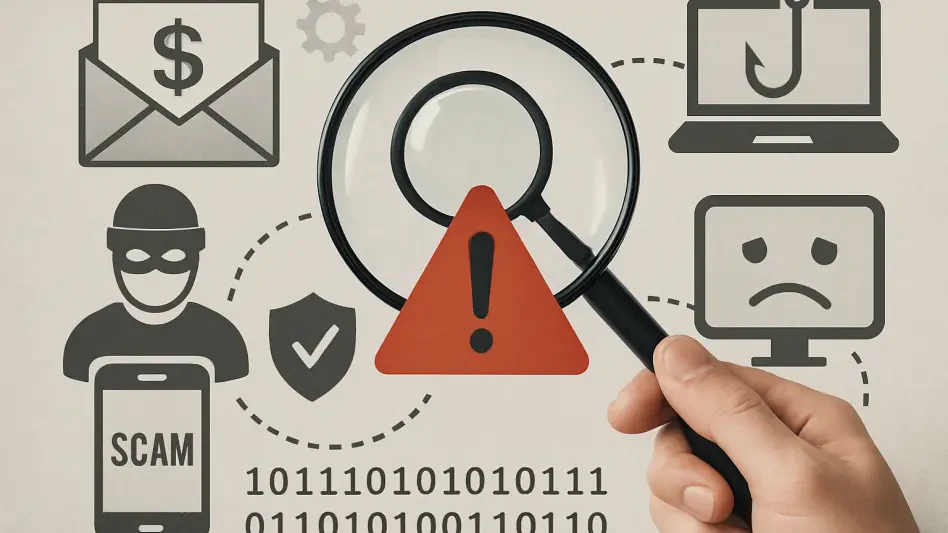Imagine a world where a single individual, armed with just a laptop and accessible software, can orchestrate a scam so convincing that even the most cautious online users fall victim to it, marking a chilling new era in cybercrime. This is no longer a distant threat but a stark reality fueled by rapid advancements in generative AI (GenAI). Fraudsters are leveraging this technology to transform traditional scams into highly sophisticated, automated operations that mimic legitimate interactions with alarming precision. From flawless phishing emails to lifelike videos of fake influencers, these AI-powered scams are eroding the foundation of digital trust. As cybercriminals exploit GenAI to craft text, images, voices, and videos, the line between authentic and deceptive content blurs, posing significant risks to individuals and brands alike. This article delves into the mechanics of these modern fraud schemes, exploring how they operate, their impact on society, and the critical steps needed to combat them.
1. Unveiling the AI-Enhanced Fraud Landscape
The rise of generative AI has revolutionized the way cybercriminals approach fraud, turning once-clumsy scams into polished, high-speed operations. In the past, scams were often easy to spot due to grammatical errors, poorly designed websites, or awkward interactions. Now, GenAI tools enable fraudsters to bypass these telltale signs by producing content that mirrors trusted sources with uncanny accuracy. This technology can generate realistic product photos, personalized messages, and even fake videos in mere minutes, lowering the barrier for entry into cybercrime. What once required a team of skilled individuals can now be executed by a single person with basic computer knowledge, amplifying the scale and reach of these deceptive schemes.
This shift has profound implications for digital trust, as the proliferation of AI-driven scams undermines confidence in online interactions. When consumers encounter counterfeit products or fake promotions that appear legitimate, brand loyalty suffers, and reputational damage becomes a real concern for companies. The ability of scammers to replicate authentic branding and communication styles means that even vigilant users may second-guess what they see online. As these threats continue to evolve, understanding how GenAI supercharges cybercriminal activity is essential to developing effective defenses against this growing menace.
2. Perfecting Phishing with AI-Generated Text
Phishing scams have long relied on tricking victims into visiting fraudulent websites, but AI has made the bait nearly irresistible. Modern tools allow cybercriminals to craft messages that replicate the tone, style, and language of trusted entities in seconds. These messages are free of spelling or grammatical errors, can be translated into any language with natural phrasing, and are often personalized to target specific individuals based on prior profiling. Once a victim clicks a suspicious link, they are directed to an AI-generated fake website, complete with cloned logos and interactive features that mimic the real thing, making detection incredibly challenging.
The speed and sophistication of these phishing operations have surged with AI, as creating convincing fake websites no longer demands advanced web design skills. Cybercriminals can now use simple platforms to clone login portals in under a minute, hosting them on legitimate infrastructure to avoid suspicion. For victims, the outcome remains the same—stolen personal information or financial loss—but the polished execution increases the likelihood of falling for the ruse. This evolution of phishing underscores the urgent need for heightened awareness and robust tools to identify and block such threats before they cause harm.
3. Crafting Illusions with AI Image Generation
Generative AI’s ability to produce lifelike images has opened new avenues for fraud, enabling scammers to create counterfeit goods and personas that appear strikingly real. These tools can generate images of products with flawless packaging, perfect lighting, and stolen brand identities, making them indistinguishable from genuine items at first glance. Beyond physical goods, cybercriminals use this technology to fabricate romantic partners for online dating scams, creating personas that cannot be traced back to real individuals through reverse image searches, thus deepening the deception.
The impact of AI-generated images extends to building false trust through fabricated customer reviews and emotionally engaging interactions. Scammers employ AI to write convincing testimonials that accompany fake products, luring victims into purchases that never materialize. In romance scams, AI-crafted messages build rapport with victims, exploiting emotional vulnerabilities until a fabricated crisis prompts requests for financial assistance. These tactics highlight how AI imagery transforms traditional fraud into a more insidious threat, preying on human trust with unprecedented realism and scale.
4. Sealing Deception with AI Video Generation
Where static images might leave room for doubt, AI-generated videos often eliminate skepticism by presenting dynamic, lifelike content. Fraudsters can create videos featuring lookalikes of influencers, celebrities, or even loved ones, complete with natural gestures, realistic speech, and familiar faces that resonate with victims. These videos are deployed in various scams, from fake social media endorsements for nonexistent products to cryptocurrency investment schemes and chilling “virtual kidnapping” scenarios where a loved one appears to be in distress.
The accessibility and affordability of AI video tools have amplified their misuse in social engineering. Reports indicate instances of AI-generated influencer videos promoting deceptive giveaways, while clusters of synthetic influencers on platforms push fraudulent wellness products to thousands before intervention occurs. Advances in this technology mean that highly convincing footage can be produced faster and cheaper than ever, posing a significant challenge for individuals and organizations to distinguish fact from fiction in an increasingly manipulated digital space.
5. Exploiting Trust through AI Voice Cloning
Voice cloning technology has reached a point where a few seconds of audio can replicate a person’s tone, accent, and speaking style with startling accuracy. Cybercriminals exploit this by mimicking familiar voices—be it a boss, family member, or friend—to manipulate victims into sharing sensitive information or transferring funds. Combined with AI-generated visuals and text, cloned voices create multi-layered scams that are difficult to detect, often preying on emotional triggers to bypass rational scrutiny.
The potency of voice cloning lies in its ability to evoke strong emotional responses, making it a powerful tool for fraud. Documented cases reveal scammers impersonating CEOs to authorize urgent transactions, using publicly available audio and AI to deceive employees. As this technology becomes more accessible and lifelike, the potential for harm grows, necessitating stronger verification processes and public education to counter these deeply personal and persuasive attacks on trust.
6. Inside the AI Scam Factory Mechanics
Scams have historically required coordinated teams with expertise in design, writing, and editing to appear credible, but AI and automation have dismantled these prerequisites. Today, a single individual can orchestrate a high-quality scam in hours using accessible tools at minimal cost. GenAI enables the creation of professional-grade product images, realistic videos, cloned voices, convincing websites, and targeted messages, all of which can be seamlessly integrated into a cohesive fraudulent campaign.
Automation further streamlines this process, connecting various elements so that scams operate with little human intervention. Research telemetry from June to September this year indicates that romance impostor scams dominate detections, comprising over three-quarters of reported incidents, with merchandise fraud following closely. This shift illustrates how AI lowers the effort needed for large-scale deception, demanding greater vigilance from businesses and individuals to combat the speed and sophistication of these modern fraud factories.
7. Simulating the AI Scam Assembly Line
To understand the mechanics of AI-powered fraud, researchers utilized n8n, an open-source automation platform, to simulate a scam setup for study purposes without harmful intent. This agentic workflow operates like an assembly line, with AI agents handling sequential tasks using commercial services for image generation, text-to-speech, and video creation. The process begins with a trigger detecting a new image, converting it into binary data, and editing it to resemble a “limited edition” luxury item for a specific demographic.
Subsequent steps involve preparing materials with upload credentials and marketing scripts, uploading assets for validation, removing image backgrounds, compositing with stock avatars, and creating animated videos with synchronized AI voice-overs. The result is polished, scalable content for fake ads or online listings, demonstrating how modular prompts and templates allow fraudsters to produce countless variations swiftly. Real-world reports confirm that such automation powers counterfeit operations, with bots managing listings and mimicking legitimate seller behavior across platforms.
8. Assessing the Wider Fallout of AI-Driven Fraud
The sophistication of counterfeit networks has surged with AI, enabling fraudsters to publish hundreds of fake listings simultaneously, adjust pricing in real-time, and craft reviews with localized language for authenticity. These tools create a self-sustaining fraud ecosystem that operates continuously, scheduling posts, promoting deals during peak times, and responding to buyers instantly—all without human oversight. This relentless automation exploits human trust, capitalizing on impulsive decisions to drive fraudulent transactions.
Despite growing awareness, a significant gap in consumer behavior persists. Studies from a couple of years ago showed that while a majority expressed concern over AI-driven fraud during high shopping seasons, many still purchased from unfamiliar sites offering enticing deals. Additionally, AI-generated avatars and videos of fake influencers endorsing products blur the boundary between genuine and deceptive content, further complicating the ability to discern truth in a crowded digital marketplace.
9. Building Defenses Against AI-Powered Scams
Countering the rise of AI-driven fraud requires a multi-faceted approach, starting with technological solutions. Some brands are embedding invisible watermarks and cryptographic signatures into media to verify authenticity, while specialized tools scan for deepfakes and synthetic content in real-time. These innovations aim to detect and flag fraudulent material before it causes harm, providing a critical layer of protection for users navigating an increasingly deceptive online environment.
However, technology alone is insufficient without user awareness and proactive habits. Educating individuals to scrutinize URLs, email addresses, and product details before acting remains vital. During peak shopping seasons, extra caution is needed to spot suspicious discounts or overly positive reviews. Limiting personal information shared online, analyzing listings for AI-generated text, and reporting suspicious content promptly can further mitigate risks. By combining advanced tools with vigilant practices, the impact of AI-powered scams can be significantly reduced.
10. Reflecting on Solutions for a Safer Digital Future
Looking back, the dual nature of generative AI became evident as it empowered scammers with tools to create convincing, scalable frauds while also revealing predictable patterns that could be identified with the right knowledge. The battle against these sophisticated scams demanded a blend of personal caution and technological innovation to protect both individuals and organizations from ever-evolving threats.
Moving forward, the focus shifted to actionable strategies that fortified digital defenses. Combining constant vigilance with smart habits—like pausing before trusting online content and guarding personal data—proved essential in blocking deceptive schemes. Leveraging advanced detection tools alongside public education ensured that users stayed ahead of cybercriminals. These efforts underscored a collective responsibility to adapt and respond, paving the way for a more secure digital landscape where trust could be rebuilt and maintained.








